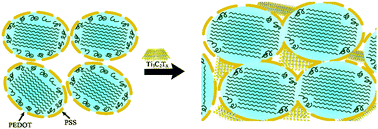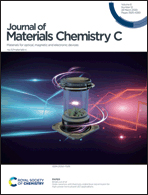Modifying the nanostructures of PEDOT:PSS/Ti3C2TX composite hole transport layers for highly efficient polymer solar cells†
Abstract
Two-dimensional (2D) transition metal carbides, MXenes, typically represented by Ti3C2TX, have shown great promise in optoelectronic devices due to their metallic electrical conductivity, large surface area, superior hydrophilicity and excellent transparency. Herein, to improve the conductivity of polymer poly(3,4-ethylenedioxythiophene):poly(styrenesulfonate) (PEDOT:PSS) films, we incorporate solution-processable 2D Ti3C2TX nanosheets into PEDOT:PSS to fabricate PEDOT:PSS/Ti3C2TX composite layers, and polymer solar cells (PSCs) with PEDOT:PSS/Ti3C2TX composite films as hole transport layers (HTLs) are fabricated for the first time. The nanostructures and the corresponding hole injection properties of PEDOT:PSS/Ti3C2TX composite layers are systematically evaluated. Based on the non-fullerene PBDB-T:ITIC system, a power conversion efficiency (PCE) of 11.02% is obtained for the device with PEDOT:PSS/Ti3C2TX as the HTL, which is improved by 13.5% compared to that of the control device with pure PEDOT:PSS as the HTL (9.72%). When using the PM6:Y6 system as the active layer, the PCE of the device based on PEDOT:PSS/Ti3C2TX is improved to 14.55% from 13.10% for the PEDOT:PSS reference device. 2D Ti3C2TX nanoflakes with higher conductivity construct additional charge transfer pathways between the PEDOT nanocrystals and induce conformational transition of PEDOT from a coil to a linear/expanded-coil structure, leading to an improvement in conductivity and device performance. Interestingly, PEDOT:PSS/Ti3C2TX based devices also exhibit enhanced long-term stability compared to PEDOT:PSS based devices. These results show that PEDOT:PSS/Ti3C2TX composite films have a promising prospect in high efficiency organic optoelectronics.



 Please wait while we load your content...
Please wait while we load your content...